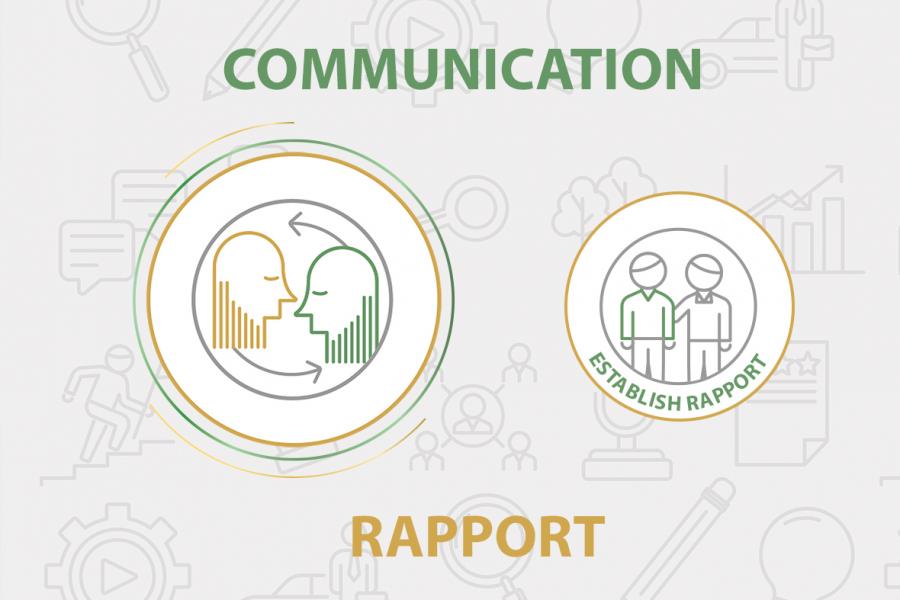 Effective Communication -Establishing Rapport
Effective Communication -Establishing Rapport
Learning ways to relate to others that creates trust and understanding through rapport.
Effective Communication - Establishing Rapport
Case Study
Ayanda has just started her career with Student Support Services at a local FET College six months ago, and she's in trouble. In her previous job she was not required to interact directly with students but now she has to. She doesn't seem to connect with students and often struggles to set meetings as she can't get students to commit to their appointments. Just as Ayanda is ready to give up and look for alternative employment, Ross Stevens, her manager, pays her a visit.
Ross Stevens tells Ayanda that she isn't a bad counsellor, she just needs to learn how to build rapport with a new group of students. He explains that rapport refers to a relationship where there is mutual trust and understanding that all parties involved have each other's best interests in mind. Rapport building is the process of building trust between two or more people.
To help Ayanda better understand, Ross draws a small diagram to show her where two people can build rapport with one another. First, he draws two overlapping circles and he labels the first circle 'you'. On the second label he writes 'others' and in the overlap he writes 'rapport'.
He explains that the first circle represents Ayanda and her interests. The second circle represents students and their interests. If Ayanda only focuses on her circle she will seem selfish, and if Ayanda only focuses on meeting the interests in students’ circle, she may seem desperate or untrustworthy. Ross tells Ayanda to imagine she is a student and the counsellor is overly eager to meet her needs. She might begin to think they are up to something or lying. On the other hand, if the counsellor is only talking about why she loves counselling, Ayanda will likely feel like the counsellor is cold and not interested in her needs.
Now, pointing to the overlapping area, Ross says that he likes to call this the zone of rapport. This is the area where interests, common ground and ability to exhibit empathy allow you to develop rapport. Connecting with someone in this area can help you quickly establish the characteristics of good rapport. For example, if the counsellor identifies how and why Student Support Services meets the students’ needs, then students are more likely to trust them. Finding interests and common ground can be the start of a lasting relationship.
Establishing Rapport
- Be sincerely and genuinely engaged in the therapeutic relationship.
- Feel empathy for the client.
- Have unconditional positive regard for the client.
- Clearly communicate these attitudes.
- Learn the names and dispositions of clients.
- Be culturally mindful and appropriate.
- Remember the basics of good communication.
- Find common ground.
- Create shared experiences.
- Be empathetic.
- Mirror and match mannerisms and speech appropriately.
- Use your active listening skills to understand the client and their story. Demonstrate to the client that you understand where they are coming from.
- Watch your speed of intimacy. Depending on the client’s culture, background and personality, it may take longer to build the trust required to discuss more personal and sensitive issues.
- Before trying to solve your client's bigger issues, try giving helpful information, positive feedback or encouragement. You may try an intervention on a smaller problem first. This will help the client build confidence in you.
- Treat the client with respect. Imagine how you would like to be treated as a client and adjust your behaviour accordingly.
- Match styles. Watch your client and become aware of their communication style. Often the client will match the practitioner’s style and will begin to calm down.
- Be competent. Ensure you have proper training and experience before tackling a client’s issues.
- Self-disclosure. Disclosing personal information is another way to build rapport. But be careful with this one, as too much disclosure, done too early and for the wrong reasons can easily backfire.
- Observe the client’s body language. If the client rests her cheek on her left hand, consider mirroring her by doing the same with your right hand.
- Adopt a similar character. If the client is introverted or extroverted, shy or exuberant, you could behave in the same way. If she's reserved, then the practitioner should be too or you might be seen as brash or invasive.
- Use the same language style. If the client uses simple, direct words, then you could too.
- Match the client's speech patterns such as tone, tempo and volume. For instance, if she/he speaks softly and slowly, then lower the volume and tempo of your voice.
Remember, the relationship is really the most important factor in the room. It matters more than the theory and interventions you use.
Shared under a Creative Commons Attribution-NonCommercial-ShareAlike 2.0 South Africa (CC BY-NC-SA 2.0 ZA)
This means you can share and adapt this work but not for commercial purposes. You will only need to include the following reference to the original content in all shared works.
Kindly attribute as follows:
Beukes, C. J., Mahadave, K., & Kanhai, K. (2022). Professional Development Portfolio for Career Development Practitioners (1st ed.). CC BY-NC-SA 2.0 ZA, https://creativecommons.org/licenses/by-nc-sa/2.0/za
Authors
![]() Karuna Mahadave
Karuna Mahadave
![]() Christopher John Beukes
Christopher John Beukes

You can earn 1.00 CPD point/s by completing and passing the self-assessment questionnaire for this article.
1.00